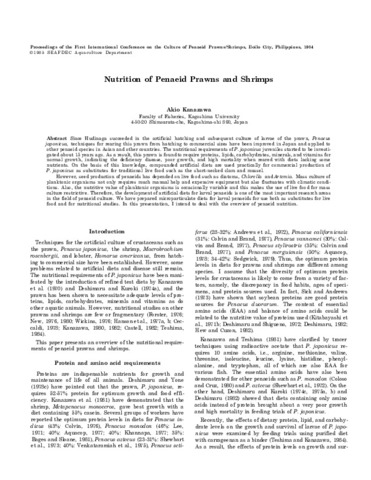Nutrition of penaeid prawns and shrimps
| dc.contributor.author | Kanazawa, Akio | |
| dc.contributor.editor | Taki, Yasuhiko | |
| dc.contributor.editor | Primavera, Jurgenne H. | |
| dc.contributor.editor | Llobrera, Jose A. | |
| dc.date.accessioned | 2012-04-13T08:31:53Z | |
| dc.date.available | 2012-04-13T08:31:53Z | |
| dc.date.issued | 1985 | |
| dc.identifier.citation | Kanazawa, A. (1985). Nutrition of penaeid prawns and shrimps. In Taki Y., Primavera J.H. and Llobrera J.A. (Eds.). Proceedings of the First International Conference on the Culture of Penaeid Prawns/Shrimps, 4-7 December 1984, Iloilo City, Philippines (pp. 123-130). Iloilo City, Philippines: Aquaculture Department, Southeast Asian Fisheries Development Center. | en |
| dc.identifier.isbn | 9718511008 | |
| dc.identifier.uri | http://hdl.handle.net/10862/879 | |
| dc.description.abstract | Since Hudinaga succeeded in the artificial hatching and subsequent culture of larvae of the prawn, Penaeus japonicus, techniques for rearing this prawn from hatching to commercial sizes have been improved in Japan and applied to other penaeid species in Asian and other countries. The nutritional requirements of P. japonicus juveniles started to be investigated about 15 years ago. As a result, this prawn is found to require proteins, lipids, carbohydrates, minerals, and vitamins for normal growth, indicating the deficiency disease, poor growth, and high mortality when reared with diets lacking some nutrients. On the basis of this knowledge, compounded artificial diets are used practically for commercial production of P. japonicus as substitutes for traditional live food such as the short-necked clam and mussel. However, seed production of penaeids has depended on live food such as diatoms, Chlorella and Artemia. Mass culture of planktonic organisms not only requires much manual help and expensive equipment but also fluctuates with climatic conditions. Also, the nutritive value of planktonic organisms is occasionally variable and this makes the use of live food for mass culture restrictive. Therefore, the development of artificial diets for larval penaeids is one of the most important research areas in the field of penaeid culture. We have prepared microparticulate diets for larval penaeids for use both as substitutes for live food and for nutritional studies. In this presentation, I intend to deal with the overview of penaeid nutrition. | en |
| dc.language.iso | en | en |
| dc.publisher | Aquaculture Department, Southeast Asian Fisheries Development Center | en |
| dc.relation.ispartof | Proceedings of the First International Conference on the Culture of Penaeid Prawns/Shrimps, 4-7 December 1984, Iloilo City, Philippines | en |
| dc.subject | Penaeus japonicus | en |
| dc.title | Nutrition of penaeid prawns and shrimps | en |
| dc.type | Conference paper | en |
| dc.citation.spage | 123 | |
| dc.citation.epage | 130 | |
| dc.citation.conferenceTitle | Proceedings of the First International Conference on the Culture of Penaeid Prawns/Shrimps, 4-7 December 1984, Iloilo City, Philippines | en |
| dc.citation.conference | First International Conference on the Culture of Penaeid Prawns/Shrimps, 4-7 December 1984, Iloilo City, Philippines | en |
| dc.subject.asfa | artificial feeding | en |
| dc.subject.asfa | diet | en |
| dc.subject.asfa | shrimp culture | en |


